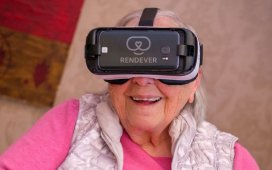The growing potential of VR as a form of enhanced learning
As global lockdowns triggered a rethink around the concept of working from home, it also caused many in the education space to rethink existing educational structures, teaching methods and solutions. While this was already well underway before the pandemic hit, the realities and shortcomings of home schooling for millions of children worldwide has galvanised the movement.
What has been made abundantly clear is that just providing children with devices for learning isn’t anywhere close to the answer when it comes to decentralised learning. Access is no longer the problem it once was. But, despite how we’ve moved from chalkboards and textbooks to laptops and apps, educators around the world have failed to make the most of advances in technology when it comes to enhancing the core educational experience. To maximise engagement, learning needs to be far more immersive, which makes virtual reality (VR) the natural next step, and a potential game-changer, in terms of moving education out of the classroom.
“But, despite how we’ve moved from chalkboards and textbooks to laptops and apps, educators around the world have failed to make the most of advances in technology when it comes to enhancing the core educational experience”
VR in-demand
While we often hear tales of VR being trialed in classrooms, the technology runs up against the same problem it has faced in the gaming space. It’s often expensive, lacks the content to be a good investment, can be hard to control, and is frequently sidelined as a niche interest. But thanks to lowering costs and a more refined user experience paving the way to more mass market adoption, demand for AR and VR in education is expected to rise in the coming years – meaning we will inevitably see teachers taking steps to bring the benefits of virtual reality into the classroom.
Uses for AI in education have become incredibly broad, including things like virtual field trips from the comfort of school desks all the way up to high tech medical training for student doctors, but all of them cover the same few bases that set them apart from traditional educational tools. They are immersive, putting users at the heart of the experience, making the subject matter ‘come alive’ and be far more tangible than other experiences . They are meaningful in that they are best used as guided experiences rather than free-form sandboxes, as this takes advantage of VR’s capacity for immersive storytelling. Finally, they are adaptable; they respond to student input and allow for a degree of exploration at their own pace, with simple controls and easy instructions.
With the basics and the advantage of VR learning nailed down, we’re seeing an exciting shift from VR being in the classroom to the possibility of VR becoming the classroom.
Endless possibilities
The ability for anyone anywhere to put on a headset and be in the same virtual classroom as people hundreds of miles away is a huge step towards a future of decentralised learning. This takes the idea beyond what can be achieved with a video call, allowing for seamless group learning, close to what you would experience in a real classroom or lecture hall. VR education gives the opportunity to make learning experiences social by allowing students to communicate with each other. Using avatars and mapped facial expressions, people can come together to discuss, collaborate and learn from each other.
This is what companies like XRSPACE are trying to accomplish. By working closely with schools in Taiwan, its VR classroom solution allows young students to approach challenging concepts within intricately designed VR experiences in a deliberate and measurable way. Maths problems become virtual escape rooms, astronomy topics become visualised in high-def immersive sessions. Students can take in every detail of renowned pieces of art in virtual galleries, learn English vocabulary with the corresponding object in hand, while on a virtual trip to the icy surface of Pluto.
Crucially, teachers have full control over the curriculum through a mobile app, allowing them to maintain order both in and outside of VR and measure students’ engagement and outcomes. This is important not only from an educational standpoint (using VR as a tool rather than just a toy) but also for the advancement of VR in education as a whole. The more teachers become proficient with this technology, the more input they can have when creating VR classrooms and educational content.
VR remains one of the greatest potential game changers for education. It offers a real departure from the outdated Prussian model of facts and memorisation, to something more experiential and fulfilling. While mass adoption of VR is still some way in the future, establishing the technology with the next generation while they are still young will be a huge factor in making sure VR continues to push the boundaries of what’s possible for decades to come.
Quelle:




